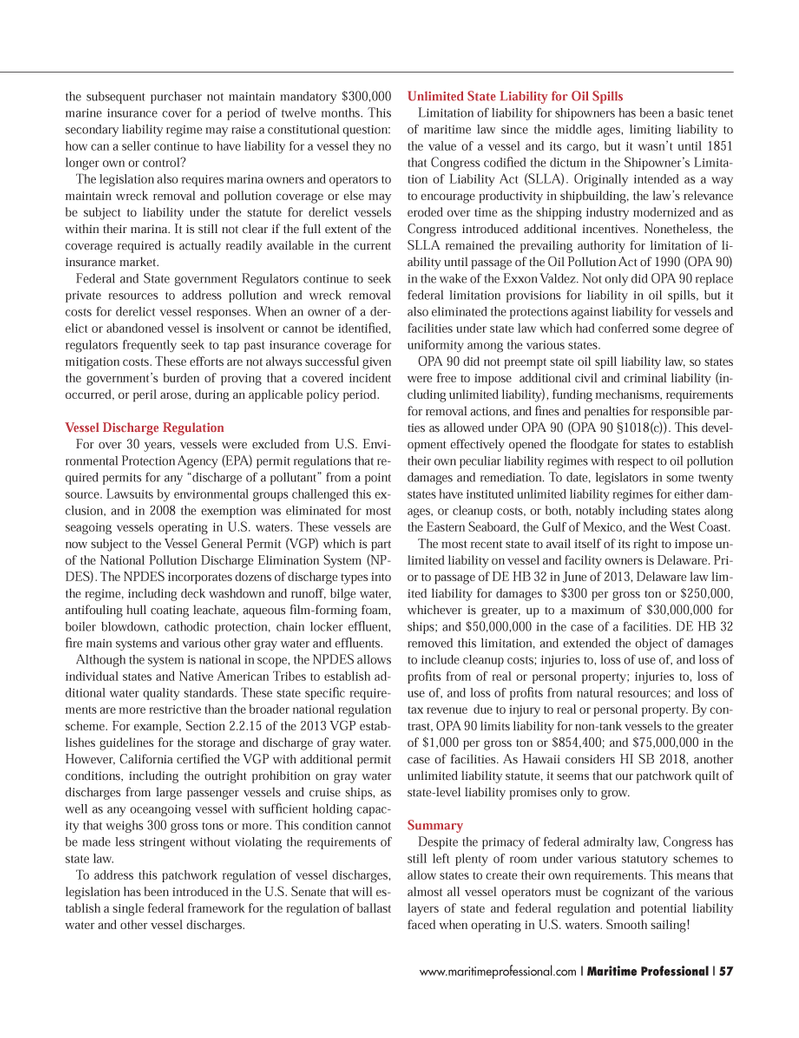
Page 57: of Maritime Logistics Professional Magazine (Q2 2014)
Maritime Risk & Shipping Finance
Read this page in Pdf, Flash or Html5 edition of Q2 2014 Maritime Logistics Professional Magazine
the subsequent purchaser not maintain mandatory $300,000 marine insurance cover for a period of twelve months. This secondary liability regime may raise a constitutional question: how can a seller continue to have liability for a vessel they no longer own or control?
The legislation also requires marina owners and operators to maintain wreck removal and pollution coverage or else may be subject to liability under the statute for derelict vessels within their marina. It is still not clear if the full extent of the coverage required is actually readily available in the current insurance market.
Federal and State government Regulators continue to seek private resources to address pollution and wreck removal costs for derelict vessel responses. When an owner of a der- elict or abandoned vessel is insolvent or cannot be identifi ed, regulators frequently seek to tap past insurance coverage for mitigation costs. These efforts are not always successful given the government’s burden of proving that a covered incident occurred, or peril arose, during an applicable policy period.
Vessel Discharge Regulation
For over 30 years, vessels were excluded from U.S. Envi- ronmental Protection Agency (EPA) permit regulations that re- quired permits for any “discharge of a pollutant” from a point source. Lawsuits by environmental groups challenged this ex- clusion, and in 2008 the exemption was eliminated for most seagoing vessels operating in U.S. waters. These vessels are now subject to the Vessel General Permit (VGP) which is part of the National Pollution Discharge Elimination System (NP-
DES). The NPDES incorporates dozens of discharge types into the regime, including deck washdown and runoff, bilge water, antifouling hull coating leachate, aqueous fi lm-forming foam, boiler blowdown, cathodic protection, chain locker effl uent, fi re main systems and various other gray water and effl uents.
Although the system is national in scope, the NPDES allows individual states and Native American Tribes to establish ad- ditional water quality standards. These state specifi c require- ments are more restrictive than the broader national regulation scheme. For example, Section 2.2.15 of the 2013 VGP estab- lishes guidelines for the storage and discharge of gray water.
However, California certifi ed the VGP with additional permit conditions, including the outright prohibition on gray water discharges from large passenger vessels and cruise ships, as well as any oceangoing vessel with suffi cient holding capac- ity that weighs 300 gross tons or more. This condition cannot be made less stringent without violating the requirements of state law.
To address this patchwork regulation of vessel discharges, legislation has been introduced in the U.S. Senate that will es- tablish a single federal framework for the regulation of ballast water and other vessel discharges.
Unlimited State Liability for Oil Spills
Limitation of liability for shipowners has been a basic tenet of maritime law since the middle ages, limiting liability to the value of a vessel and its cargo, but it wasn’t until 1851 that Congress codifi ed the dictum in the Shipowner’s Limita- tion of Liability Act (SLLA). Originally intended as a way to encourage productivity in shipbuilding, the law’s relevance eroded over time as the shipping industry modernized and as
Congress introduced additional incentives. Nonetheless, the
SLLA remained the prevailing authority for limitation of li- ability until passage of the Oil Pollution Act of 1990 (OPA 90) in the wake of the Exxon Valdez. Not only did OPA 90 replace federal limitation provisions for liability in oil spills, but it also eliminated the protections against liability for vessels and facilities under state law which had conferred some degree of uniformity among the various states.
OPA 90 did not preempt state oil spill liability law, so states were free to impose additional civil and criminal liability (in- cluding unlimited liability), funding mechanisms, requirements for removal actions, and fi nes and penalties for responsible par- ties as allowed under OPA 90 (OPA 90 §1018(c)). This devel- opment effectively opened the fl oodgate for states to establish their own peculiar liability regimes with respect to oil pollution damages and remediation. To date, legislators in some twenty states have instituted unlimited liability regimes for either dam- ages, or cleanup costs, or both, notably including states along the Eastern Seaboard, the Gulf of Mexico, and the West Coast.
The most recent state to avail itself of its right to impose un- limited liability on vessel and facility owners is Delaware. Pri- or to passage of DE HB 32 in June of 2013, Delaware law lim- ited liability for damages to $300 per gross ton or $250,000, whichever is greater, up to a maximum of $30,000,000 for ships; and $50,000,000 in the case of a facilities. DE HB 32 removed this limitation, and extended the object of damages to include cleanup costs; injuries to, loss of use of, and loss of profi ts from of real or personal property; injuries to, loss of use of, and loss of profi ts from natural resources; and loss of tax revenue due to injury to real or personal property. By con- trast, OPA 90 limits liability for non-tank vessels to the greater of $1,000 per gross ton or $854,400; and $75,000,000 in the case of facilities. As Hawaii considers HI SB 2018, another unlimited liability statute, it seems that our patchwork quilt of state-level liability promises only to grow.
Summary
Despite the primacy of federal admiralty law, Congress has still left plenty of room under various statutory schemes to allow states to create their own requirements. This means that almost all vessel operators must be cognizant of the various layers of state and federal regulation and potential liability faced when operating in U.S. waters. Smooth sailing! www.maritimeprofessional.com | Maritime Professional | 57 50-63 Q2 MP2014.indd 57 5/16/2014 3:01:47 PM

 56
56

 58
58
